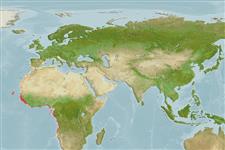Actinopterygii (ray-finned fishes) >
Perciformes (Perch-likes) >
Scombridae (Mackerels, tunas, bonitos) > Scombrinae
Etymology: Scomberomorus: Latin, scomber = mackerel + Greek, moros = silly, stupid (Ref. 45335).
Environment / Climate / Range
Ecology
Marine; brackish; pelagic-neritic; oceanodromous (Ref. 51243); depth range 1 - 40 m (Ref. 28173), usually 20 - 25 m (Ref. 28173). Tropical, preferred 24°C (Ref. 107945); 45°N - 19°S, 24°W - 14°E (Ref. 168)
Eastern Atlantic: Canary Islands and Senegal to the Gulf of Guinea and Baía dos Tigres, Angola. Rarely found in the northern Mediterranean Sea, along the coasts of France and Italy. This species has been erroneously been considered as a synonym of Scomberomorus maculatus by many authors.
Length at first maturity / Size / Weight / Age
Maturity: Lm 37.3, range 33 - 45 cm
Max length : 100.0 cm TL male/unsexed; (Ref. 2683); 98.0 cm FL (female); common length : 75.0 cm TL male/unsexed; (Ref. 2683); max. published weight: 6.0 kg (Ref. 40637); max. reported age: 5 years (Ref. 27160)
Dorsal
spines
(total): 15 - 18;
Dorsal
soft rays
(total): 0;
Anal
soft rays: 17 - 20;
Vertebrae: 46 - 47. Interpelvic process small and bifid. Body covered with small scales. Lateral line gradually curving down toward caudal peduncle. Intestine with 2 folds and 3 limbs. Swim bladder absent. Some large individuals with thin vertical bars. Anterior half of first dorsal fin and margin of posterior half of first fin black.
Inhabits warm waters (Ref. 2683). Forms school close to the shore (Ref. 9987). Enters coastal lagoons and feeds on clupeids particularly Ethmalosa fimbriata. Reproduces in July to August (Ref. 5377). Eggs and larvae are pelagic (Ref. 6769). Utilized fresh, dried-salted, smoked and frozen (Ref. 9987).
Collette, B.B. and C.E. Nauen, 1983. FAO Species Catalogue. Vol. 2. Scombrids of the world. An annotated and illustrated catalogue of tunas, mackerels, bonitos and related species known to date. Rome: FAO. FAO Fish. Synop. 125(2):137 p. (Ref. 168)
IUCN Red List Status (Ref. 115185)
CITES (Ref. 94142)
Not Evaluated
Threat to humans
Harmless
Human uses
Fisheries: commercial
More information
ReferencesAquacultureAquaculture profileStrainsGeneticsAllele frequenciesHeritabilityDiseasesProcessingMass conversion
Tools
Special reports
Download XML
Internet sources
